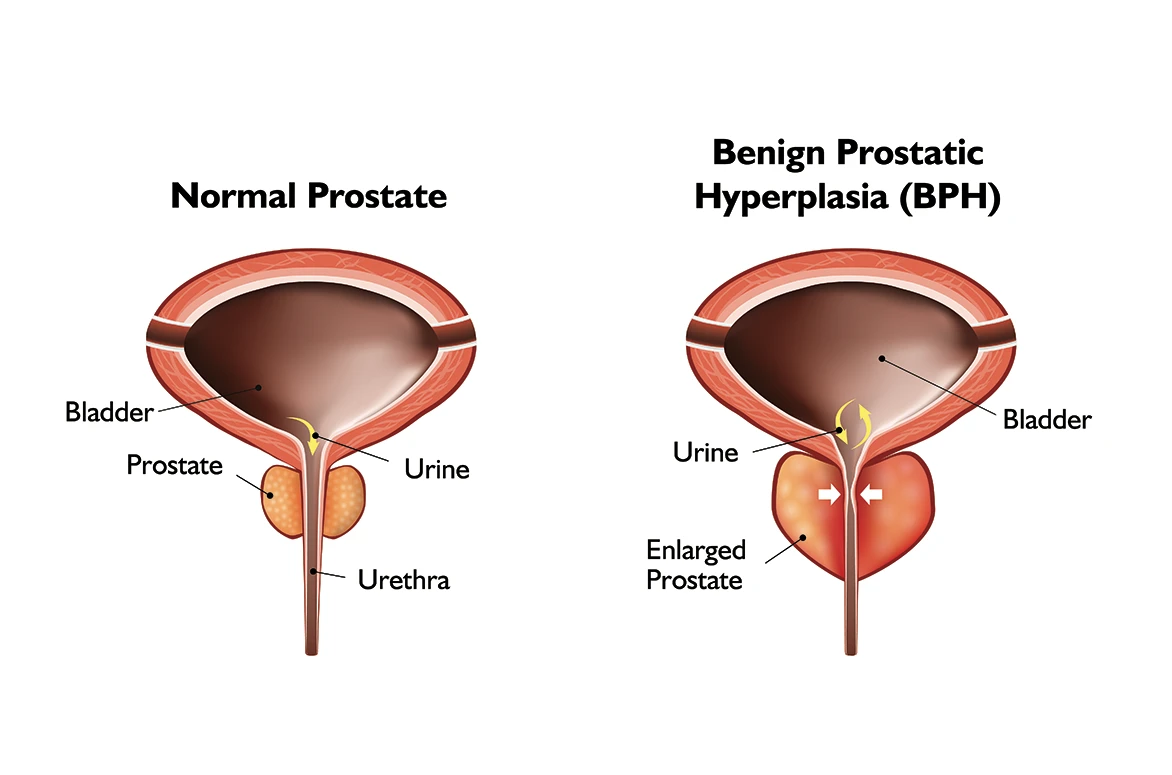Benign Prostatic Hyperplasia
Get Benign Prostatic Hyperplasia Treatment From the Urologic Institute
What is BPH
Benign Prostatic Hyperplasia, or BPH, is a condition in which the prostate enlarges as men get older. BPH is a very common condition that affects over 42 million men in the US1 and over 660 million aging men worldwide.2.3 Over 40% of men in their 50s and over 70% of men in their 60s have BPH.2 While BPH is a benign condition and unrelated to prostate cancer, it can greatly affect a man’s quality of life.

BPH Symptoms
As the prostate enlarges, it presses on and blocks the urethra, causing bothersome urinary symptoms. If left untreated, BPH can lead to permanent bladder damage. Symptoms include:
- Frequent need to urinate both day and night
- Weak or slow urinary stream
- A sense that you cannot completely empty your bladder
- Difficulty or delay in starting urination
- Urgent feeling of needing to urinate
- A urinary stream that stops and starts
Symptoms of BPH can cause loss of productivity, depression, and decreased quality of life.
If you suffer from the above symptoms, you are not alone. BPH is the leading reason men visit a urologist. You can measure your BPH symptoms by taking the International Prostate Symptom Score (IPSS) questionnaire. Sharing this information with your physician will help them understand the severity of your symptoms.
What is the UroLift System?
The UroLift System is a proven minimally invasive procedure to treat an enlarged prostate. It is the only leading enlarged prostate procedure that does not require heating, cutting, or destruction of prostate tissue. The procedure is typically performed as a same-day outpatient procedure, including the office setting, under local anesthesia.
Advantages of the UroLift System
- Safe and effective
- Risk profile better than reported for surgical procedures such as TURP
- Rapid symptom relief, better than reported for medications
- Only leading BPH procedure shown not to cause new and lasting sexual dysfunction
- Covered by Medicare, national, and commercial plans
- Typically no catheter required after treatment
How Does the UroLift System Work?

Step 1:
The UroLift Delivery Device is placed through the obstructed urethra to access the enlarged prostate.
Step 2:
Small UroLift Implants are permanently placed to lift and hold the enlarged prostate tissue out of the way and increase the opening of the urethra.
Step 3:
The UroLift Delivery Device is removed, leaving an open urethra designed to provide symptom relief.
Frequently Asked Questions
BPH, the acronym for Benign Prostatic Hyperplasia (or sometimes, hypertrophy), is an enlarged prostate gland, and is not typically a serious problem, nor on its own a life-threatening condition.
BPH is considered a normal condition of aging. Although the exact cause is unknown, changes in male sex hormones that come with aging may be a factor. Any family history of prostate problems or any abnormalities with your testicles may raise your risk for BPH.
Although there is no cure for benign prostatic hyperplasia (BPH), also known as enlarged prostate, there are many useful options for treating the problem. Treatments focus on prostate growth, which is the cause of BPH symptoms.
Benign prostatic hyperplasia (BPH) — also called prostate gland enlargement — is a common condition as men get older. An enlarged prostate gland can cause uncomfortable urinary symptoms, such as blocking the flow of urine out of the bladder. It can also cause bladder, urinary tract or kidney problems.
All men with BPH should avoid medicines that can worsen symptoms or cause urinary retention. These include certain antihistamines (such as diphenhydramine [Benadryl]) and decongestants (eg, pseudoephedrine [found in some cold medicines])
